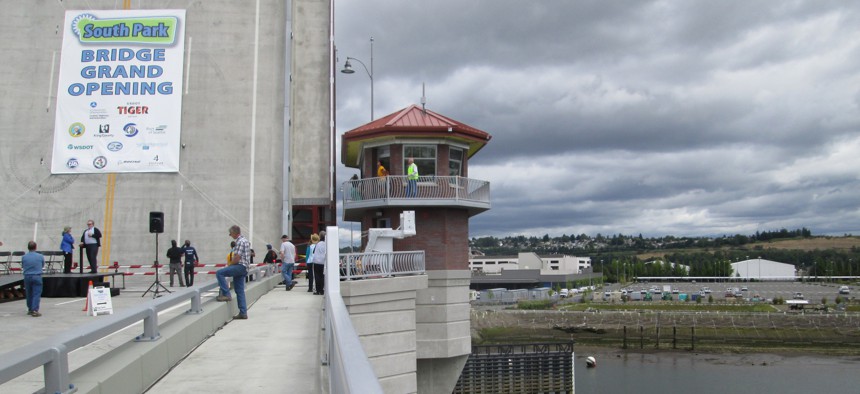Connecting state and local government leaders
In the third of a multi-part guest article series for Route Fifty, King County (Wash.) Executive Dow Constantine examines a complex issue many public officials around the United States are facing in their communities: infrastructure.
Introduction: Investing in Infrastructure
The prospects of each generation rely on the creation, preservation and expansion of infrastructure by the generation before—the built infrastructure, to be sure. But also, more broadly, natural infrastructure and human infrastructure. Only by investing in each of these indispensable, interlocking public goods will we create the opportunity for continued prosperity.
Here, though, I will focus on our built infrastructure—projects such as the Erie Canal and interstate highway system, both examples cited by financier Felix Rohatyn in stressing the importance and tradition of investing public revenue in improvements that increase the future well-being of our nation.
In his 2011 book, “Bold Endeavors: How Our Government Built America, and Why It Must Rebuild Now” Rohatyn spells out some of our specific and pressing infrastructure needs:
Three-quarters of the country’s public school buildings are outdated and inadequate. More than a quarter of the nation’s bridges are obsolete or deficient. It will take $11 billion annually to replace aging drinking water facilities. Half the locks on more than 12,000 miles of inland waterways are functionally obsolete.
According to the American Society of Civil Engineers, it would take an investment of more than $2 trillion to get all of America’s infrastructure into workable condition.
With hard-nosed global competitors like China building new airports, roads, bridges, ports and high-speed rail systems every year, we cannot continue to turn our backs on our country’s heritage of pulling together and investing in order to build for today—and tomorrow.
America’s disinvestment in infrastructure (or education, or the environment, for that matter) speaks to a corrosive but pervasive myth of our political time: that we can have everything while paying for nothing.
The bottom line is that infrastructure maintenance and upgrades are indispensible to short- and long-term quality of life for communities everywhere.
As complex as these projects may be, they also provide elected officials with a wonderful opportunity to serve voters—and to connect government to citizens in a visceral and indisputable way.
That’s how I felt last spring, when we opened the new South Park Bridge in my county.
This vital infrastructure project took three years and thousands of tons of concrete to construct. But, when it was completed in the spring of 2014, with its sweeping bascule design and its twin piers capped with brick control towers, thousands came out to celebrate the physical reconnection of their affordable, working-class community to family-wage jobs on the Boeing Field side of the Duwamish River.
Getting to this point was a real challenge, even though the problem with the old bridge was long known. People kept kicking the can down the road, even as wear and tear from 20,000 vehicle trips each day pushed the Depression-era bridge closer and closer to failure.
I could see the problem when I examined the ground-down metal teeth where the drawbridge parts met. King County inspectors saw the damage and danger, too. In 2002, the bridge earned a safety score of 6 out of a possible 100, using Federal Highway Administration criteria. That number was frighteningly low, especially considering that the I-35W Mississippi River bridge that collapsed had a score of 50.
When I was still the County Councilmember representing that stretch of the Duwamish River industrial valley, I picked up a paintbrush and signed my name to a promise painted on the wall of the boarded-up County Line Tavern at the foot of the bridge—“I hereby pledge to do all within my capacity to secure funding for the replacement of the South Park Bridge …” How to do so remained an open question.

So it came as no real shock that in late 2009—only a few days after I took office as County Executive—my transportation director came to me with news that the old bridge was crumbling so fast that it represented a life-threatening danger to the community. I had no choice but to order its closure.
Despite the obvious peril of operating the bridge, and the obvious economic impact of closing it, there was still precious little money available to replace the South Park Bridge. A big federal grant application to fund the job had been rejected. The general sentiment was that it was just too big a job to get done, especially with the recession in full swing and our transportation revenues at historic lows.
But, with so much at stake and my pledge in bright blue paint for all to see, inaction was not an option.
It was here that my insistence on collaboration and partnership really came into play.
Working with a dozen separate public and private funding partners, at all levels of federal, state and local government, we secured one financial commitment at a time.
We were propelled forward by the determination of the people in the community. They held meetings, wrote letters and made countless phone calls. All of us were motivated by concern for the estimated 70,000 jobs at risk because, without the South Park Bridge, it was very difficult for workers to get to their jobs, and for companies to get their goods to market.
In the end, with the support of this consortium of public officials and community leaders, we cobbled together the $130 million and, though still struggling through the aftermath of the Great Recession, built a new bridge.
Government worked diligently to keep a promise made to the community. And, in the process, we were able to forge bonds and connect with people who simply needed a way to get to work.
As an elected official, public service doesn’t get more fulfilling than that.
Investing in Infrastructure: Five Best Practices
- Be Transparent and Clear About the Project Need: The long-term financial implications of addressing our massive infrastructure replacement backlog are real, but it’s our job as public officials to make sure that there’s a solid and demonstrated return on investment – and that we communicate that benefit to the public with straight talk.
- Be Patient and Prepared for Bad Things to Happen: Replacing outdated infrastructure can be messy and lead to traffic delays, unexpected costs and unforeseen challenges. Before you know it, even on well-managed projects, final completion can be delayed for weeks or more. As construction grinds on, we as public officials need to keep the focus on the benefits to the public —and how this hard work will bring lasting progress.
- Keep an Equity Lens Beyond the Immediate Project: It is important not to focus on an infrastructure project too narrowly. While the demands of day-to-day project management wear on, we should never forget that a road is often not just a road; the social justice symbolism it represents to a forgotten community, and the gateway it provides to economic opportunity, should also be embraced.
- Be at Peace with Mother Nature: In our region, the hills, valleys, streams and lakes make for a beautiful place to live, but these same elements can also present profound engineering challenges. With a deep-rooted commitment to the environment, we must proactively look to design facilities in a way that is mindful of their impact on Mother Earth. This is not a nuisance, but an opportunity to show the next generation how we thoughtfully balanced competing needs.
- Your Staff Members Are Your Partners, Too: As public officials, we get to cut the ribbon and smile for the cameras when the project is complete, but we often forget the blood, sweat and tears spilled by workers to achieve this accomplishment. Sometimes, it seems like the media only becomes interested in projects when mistakes are made, and then tell the story with an angry sound bite from one frustrated employee. Keep the lines of communication within your organization open, and you won’t learn about problems from media reports.
Read more from Dow Constantine’s “Connected Government” series:
(Top image by Chas Redmond / Flickr via CC BY 2.0)
Since his election as King County Executive in November 2009, Dow Constantine has been working to instill a culture of performance that changes the way King County does business. In the process, he has forged substantive partnerships with residents, cities, employees and other county leaders to craft real, sustainable reforms. Before his election as King County Executive, he served as a King County Council member for eight years, and has held elected office in Washington state for 18 years. A Seattle native, he graduated from West Seattle High School and the University of Washington. He earned University of Washington post-graduate degrees in law and urban planning, and he lives in the same West Seattle neighborhood where he grew up.

NEXT STORY: Successfully migrating and monitoring apps in the cloud



